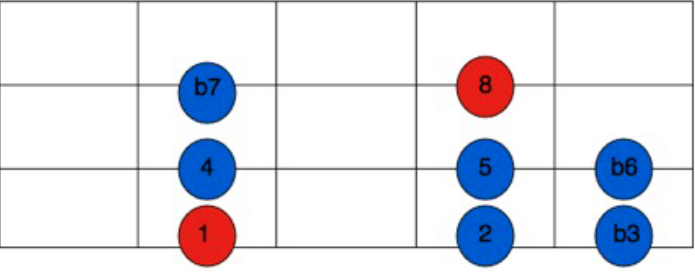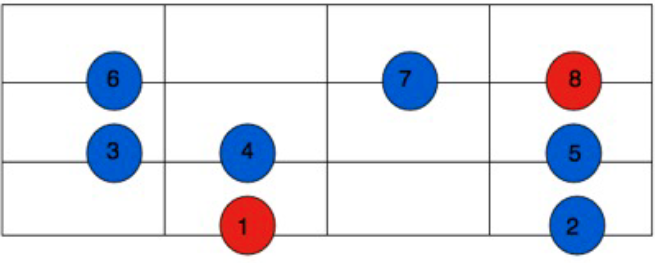The Dorian mode is a scale that starts on the second step of a major scale. It has a flat 3rd and a flat 7th note and is considered a minor scale because of the flat 3rd.
Think of the Dorian mode as just another scale for a second. Disregard all the jargon about modes and when to use them for moment. Lets approach this scale by first thinking about what a minor scale (or Aeolian mode) looks like on the fretboard:
A minor scale (or Aeolian mode) has a flat 3rd, flat 6th and flat 7th.
Now take that minor scale and make the following adjustments:
• You’re going to un-flatten the 6th note
• And keep the 3rd and the 7th notes of the scale flattened.
And there you go – you’ve now identified the core components of the Dorian scale looks like on the fretboard. Like all scales on the 4-string standard bass guitar, if you play this pattern in any location on the fretboard, you will be playing a Dorian scale (or mode).
Let’s consider some playing examples and what playing a Dorian scale actually means:
1. If we have a C major scale (or C Ionian scale or mode) it would look like this:
C D E F G A B C
or like this on the fretboard:
The Dorian scale for the key of C would look like this: D E Fb G A B Cb D. Using what we know from before:
- We’re starting on the second step (D)
- We’re applying a flat 3rd and a flat 7th to that scale
C D E F G A B C
=
D E F G A B C D*
which on the fretboard looks like this:




Unfortunately, not all of the scales and corresponding keys have no sharps and/or flats. Most of the time you’re going to encounter other sharps and flats on the 3rd and 7th notes and you’re going to need to know what to do. Luckily – the pattern for the Dorian scale stays the same!
Here’s another example:
2. If we have an Eb major scale in the key of Eb major:
Eb F G Ab Bb C D Eb
Our Dorian scale would begin on the F. We would keep all the flats that come with the key of Eb major:
F G Ab Bb C D Eb F
Now we would apply the flat 3rd and flat 7th that come with a Dorian scale. That would give us this:
F G Abb (or B natural) Bb C D Ebb (or Db) F
Which, on the fretboard, looks like this:
Try for yourself with the key of Ab Major.
- Where would the Dorian scale be?
- How would it look on the fretboard?
- What would you describe the sound of the scale to be? More major or more minor sounding? Or something inbetween?
- Lastly, experiment with it a little bit. See if you can make a bass line to a groove (try using some of the drum grooves off to the right of this site to get you started).
For more information on the modes, what they look like and how to play them – check out this cool article here:
And this video (yes- its a piano player, but the premise is still the same):
*Update: A quick change! Fb was changed to F and Cb was changed to C – the correct notes of the D Dorian scale.
- How to Set up a Pedal Board for Bassists - June 16, 2021
- The Best Bass Guitar Effects Pedals Guide You’ll Ever See [INFOGRAPHIC] - April 24, 2020
- The Ultimate Beginner’s Guide to Everything About Bass Guitar Strings - March 20, 2020

